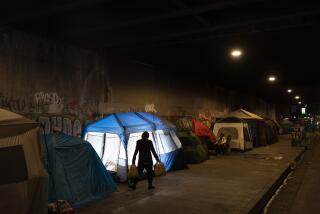Rebuilding Their Lives --and Themselves
- Share via
I hold my breath and make my way down the skid row street where the sour smell of urine rises from sidewalks littered with debris. When I reach the Downtown Women’s Center, finally, I dare to breathe.
There, the aroma of coffee brewing and bacon frying replaces the stench of the outside streets. Inside, the two dozen women eating breakfast might just as well be suburban grandmothers as homeless women, fortifying themselves for another day on the streets.
They have showered here, and brushed their hair and borrowed clean clothes from a closet full of castoffs, donated by the kind of women many of them once were.
Some tote backpacks, crammed with old letters and pictures, a clean T-shirt and a change of underwear. Others carry their belongings in shopping bags, as if they’re en route from a trip to the market. And some lean unsteadily on metal walkers, wrapped with plastic bags carrying all they own.
Some of them will spend the day at this center, chatting, watching television, reading. But at night, most will be back on the streets, held captive by personal demons and a shortage of beds and services that would help meet their needs.
Jacqueline Caver says it took four years on the street, “using every kind of drug I could get my hands on” to ready herself for the respite of a soft bed and clean sheets. And it took eight months of prodding by social workers and other homeless women to bring her to this place, where she could “watch TV, sit in a soft chair, drink tea and coffee all day long.” But it was more than creature comforts that made her stay, Caver says today. “I started helping out around here--washing dishes, helping fix the meals--and that connected me back to the life I had, the way I used to live. It brought me back,” and helped her move forward.
Now, after a year in residential drug treatment and six months in a sober living house, Caver is living at the Women’s Center, renting a room in its 47-unit apartment complex, one of the few places on skid row where women can find safe, long-term housing. “It’s not just shelter we offer, but the kind of support a woman needs to get back on her feet,” says Women’s Center Director Lisa Watson.
The center began in 1978 as a shelter for elderly, mentally-ill women made homeless by changes in mental health treatment laws. Today, it serves not just the mentally ill, but women made homeless through drug addiction or domestic abuse, as well. About 85 women come through each day for a meal, a shower, help with medical and legal problems, or just a chance to take a break from conditions on the streets.
“It is not just that they need sandwiches or shelter, but they need to begin to see themselves in a new way,” says program director Mina Kedar. That’s why the center offers dance classes, art lessons, literacy training and field trips to parks and theaters.
“We need to replace the ugliness in their lives with a new vision,” Kedar says. “And we can’t force change; we have to meet them where they are and understand their needs.”
That is why, on Saturday, 65 community volunteers met at the center and fanned out through skid row to survey homeless women. “In three hours, we talked to more than 400 women,” Watson said. “That surprised even us.”
The biggest need they cited was affordable, stable housing that would keep them off the streets, she said. There are homeless shelters along skid row, but they’re primarily geared toward men.
“That can be very intimidating for a woman,” said Angela Smaldino. A pre-school teacher, she lost her home after her divorce and stayed in residential motels until she lost her job and her money ran out. “I wound up at the Union Rescue Mission on Friday, and I was scared to death. When I walked in this place this morning, I felt so much better. There was a bed, with a quilt like one I’d had at home. I thought I would cry.”
If you had told Caver when she was young that she’d wind up a homeless grandmother, addicted to drugs, sleeping on the streets, her life’s possessions in a blue canvas bag that she toted in a shopping cart, “I would have told you you were crazy,” she said.
But when her drug addiction took hold, she lost her job as a machinist, her Watts apartment, her car and the respect of her family and friends. “When your life begins to fall apart, it’s little by little,” she says, “so you don’t even realize what’s happening.”
But workers at the Women’s Center helped her clear away enough of the debris from her shattered life that she can see a path into the future. “Now, my goals are really pretty simple,” she said. “I want to get my own place, where my grandchildren can come to visit. I want to be able to baby-sit them, so my daughter can go to college. I want to save enough money to I can help somebody else.”
More to Read
Sign up for Essential California
The most important California stories and recommendations in your inbox every morning.
You may occasionally receive promotional content from the Los Angeles Times.






